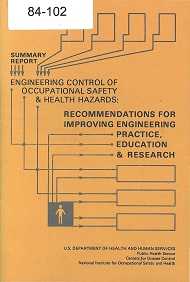Engineering Control of Occupational Safety and Health Hazards. Recommendations For Improving Engineering Practice, Education and Research
January 1984
DHHS (NIOSH) Publication Number 84-102

This document served as a summary of a series of workshops conducted to improve engineering practice, education, and research in the field of occupational safety and health. Following a brief historical review of occupational safety and health engineering, an outline was offered of occupational hazard control information needed by practicing engineers and those employed in related professions, a summary of educational needs in this field, a discussion of needed research on engineering control, and a consolidated list of high priority recommendations for action. The best stage to eliminate or control occupational hazards is considered to be at the process, machine, or facility design stage. Elimination of the man/machine interface will require further automation including the use of robotics. Engineering safeguards need to be more efficient and secure, and such safeguards must be designed for easy access and error free operation. Workers must be properly trained and motivated to follow safe procedures, and a caring attitude must be fostered among workers, particularly those engaged in hazardous occupations. Several recommendations are offered for educational institutions, for the accreditation board for engineering and technology, for NIOSH, for OSHA, for the private sector, for labor organizations, for professional engineering societies, and for future research activities.
- Page last reviewed: April 10, 2017
- Page last updated: June 20, 2017
- Content source:
- National Institute for Occupational Safety and Health Education and Information Division


 ShareCompartir
ShareCompartir